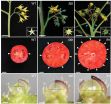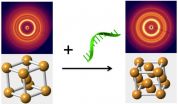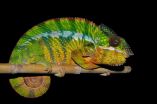Patterns of brain activity reorganize visual perception during eye movements
New research by Christopher Pack, from McGill University, suggests oscillations in brain activity have multiple roles in vision processing
2015-05-25
(Press-News.org) This news release is available in French.
Scientists measuring brain activity have found that in many regions, such as the sensory or motor cortex, activity sometimes oscillates at different frequencies, forming wave-like patterns. Despite the fact that such oscillations are frequently observed, and present in many brain regions, their functional role remains unclear. Research done by Dr. Christopher Pack, from McGill University, who looked at such waves occurring in a region of the visual cortex of the brain, suggests these oscillations could have a role in resetting the sensitivity of neurons after eye movements. Further results suggest these waves could also have a role in supporting the brain's representation of space. These results were presented at the 9th Annual Canadian Neuroscience Meeting, on May 25th 2015 in Vancouver, British Columbia.
Vision is an extremely dynamic process - Even when we look at a fixed image, our eyes are making rapid movements, called "saccades" to explore the image that is sent to our brain. By recording neuronal activity in monkeys as they performed tasks that caused saccades, Dr. Christopher Pack has shown that there are waves of activity that cross specific vision processing areas of the brain in defined patterns, and that these patterns are reorganized by saccadic eye movements. After a saccade, this wave of activity reorganizes to travel from the fovea, at the center of the visual field, and which is the area of the eye with the best visual acuity, to the periphery. As the wave passes, it is suggested to reset the sensitivity of the area, and its pattern allows visual processing to occur earlier in the fovea relative to the periphery resulting in an early focus on the object that attracted the eyes. This work was recently published in the journal Neuron (Zanos et al., 2015).
More recent work has shown that patterns of oscillations can facilitate the representation of visual space during eye movements. "This is important because each saccade shifts the position of visible objects on the retina, and hence the brain needs to know the stable positions of objects in external space", says Dr. Pack. "By permitting rapid neural communication across neurons encoding different spatial positions, oscillations could contribute to this important perceptual process."
INFORMATION:
About the Canadian Neuroscience Meeting
The Canadian Association for Neuroscience is holding its 9th Annual Meeting in Vancouver, May 24 to 27 2015. Held yearly since 2007, it brings together researchers working in all fields of neuroscience research. Organized by neuroscientists and for neuroscientists, it highlights the best and most novel neuroscience research in Canada every year.
About the Canadian Association for Neuroscience:
The Canadian Association for Neuroscience is the largest association dedicated to the promotion of all fields of neuroscience research in Canada. The association has been organizing a yearly annual meeting since 2007. Learn more about our meeting at:
http://can-acn.org/meeting2015
ELSE PRESS RELEASES FROM THIS DATE:
2015-05-25
Cold Spring Harbor, NY -- A team of scientists at Cold Spring Harbor Laboratory (CSHL) has identified a set of genes that control stem cell production in tomato. Mutations in these genes explain the origin of mammoth beefsteak tomatoes. More important, the research suggests how breeders can fine-tune fruit size in potentially any fruit-bearing crop. The research appears online today in Nature Genetics.
In its original, wild form the tomato plant produces tiny, berry-sized fruits. Yet among the first tomatoes brought to Europe from Mexico by conquistador Hernan Cortez in ...
2015-05-25
UPTON, NY -- Scientists at the U.S. Department of Energy's Brookhaven National Laboratory have just taken a big step toward the goal of engineering dynamic nanomaterials whose structure and associated properties can be switched on demand. In a paper appearing in Nature Materials, they describe a way to selectively rearrange the nanoparticles in three-dimensional arrays to produce different configurations, or phases, from the same nano-components.
"One of the goals in nanoparticle self-assembly has been to create structures by design," said Oleg Gang, who led the work ...
2015-05-25
New research conducted in a rural community in Pakistan highlights the crucial role that essential fatty acids play in human brain growth and function.
A team co-led by the University of Exeter, working with experts in Singapore, has published findings in Nature Genetics which show that mutations in the protein Mfsd2a cause impaired brain development in humans. Mfsd2a is the transporter in the brain for a special type of fat called lysophosphatidylcholines (LPCs) -- which are composed of essential fatty acids like omega-3. This shows the crucial role of these fats in ...
2015-05-25
Having a healthy gut may well depend on maintaining a complex signaling dance between immune cells and the stem cells that line the intestine. Scientists at the Buck Institute are now reporting significant new insight into how these complex interactions control intestinal regeneration after a bacterial infection. It's a dance that ensures repair after a challenge, but that also goes awry in aging fruit flies -- the work thus offers important new clues into the potential causes of age-related human maladies, such as irritable bowel syndrome, leaky gut and colorectal cancer.
"We've ...
2015-05-25
May 26, 2015, Shenzhen, China - Researchers from BGI reported the most complete haploid-resolved diploid genome (HDG) sequence based on de novo assembly with NGS technology and the pipeline developed lays the foundation for de novo assembly of genomes with high levels of heterozygosity. The latest study was published online today in Nature Biotechnology.
The human genome is diploid, and knowledge of the variants on each chromosome is important for the interpretation of genomic information. In this study, researchers presented the assembly of a haplotype-resolved diploid ...
2015-05-25
A gene essential to the production of pain-sensing neurons in humans has been identified by an international team of researchers co-led by the University of Cambridge. The discovery, reported today in the journal Nature Genetics, could have implications for the development of new methods of pain relief.
Pain perception is an evolutionarily-conserved warning mechanism that alerts us to dangers in the environment and to potential tissue damage. However, rare individuals - around one in a million people in the UK - are born unable to feel pain. These people accumulate numerous ...
2015-05-25
Scientists at the University of York's Centre for Quantum Technology have made an important step in establishing scalable and secure high rate quantum networks.
Working with colleagues at the Technical University of Denmark (DTU), Massachusetts Institute of Technology (MIT), and the University of Toronto, they have developed a protocol to achieve key-rates at metropolitan distances at three orders-of-magnitude higher than previously.
Standard protocols of Quantum Key Distribution (QKD) exploit random sequences of quantum bits (qubits) to distribute secret keys in a completely ...
2015-05-25
TORONTO, May 25, 2015 - A new, Ontario-wide study shows that rates of hospital readmission following a traumatic brain injury (TBI) are greater than other chronic diseases and injuries and are higher than previously reported.
The study, led by Dr. Angela Colantonio, senior scientist, Toronto Rehabilitation Institute, UHN, examined nearly 30,000 TBI patients discharged from Ontario hospitals over the span of eight years. Published in the May edition of Archives of Physical Medicine and Rehabilitation, the study found that about 36 per cent of patients with TBI had been ...
2015-05-25
Madagascar is home to extraordinary biodiversity, but in the past few decades, the island's forests and associated biodiversity have been under greater attack than ever. Rapid deforestation is affecting the biotopes of hundreds of species, including the panther chameleon, a species with spectacular intra-specific colour variation. A new study by Michel Milinkovitch, professor of genetics, evolution, and biophysics at the University of Geneva (UNIGE), led in close collaboration with colleagues in Madagascar, reveals that this charismatic reptilian species, which is only ...
2015-05-25
This news release is available in French. Certain blind individuals have the ability to use echoes from tongue or finger clicks to recognize objects in the distance, and some use echolocation as a replacement for vision. Research done by Dr. Mel Goodale, from the University of Western Ontario, in Canada, and colleagues around the world, is showing that echolocation in blind individuals is a full form of sensory substitution, and that blind echolocation experts recruit regions of the brain normally associated with visual perception when making echo-based assessments ...
LAST 30 PRESS RELEASES:
[Press-News.org] Patterns of brain activity reorganize visual perception during eye movements
New research by Christopher Pack, from McGill University, suggests oscillations in brain activity have multiple roles in vision processing


